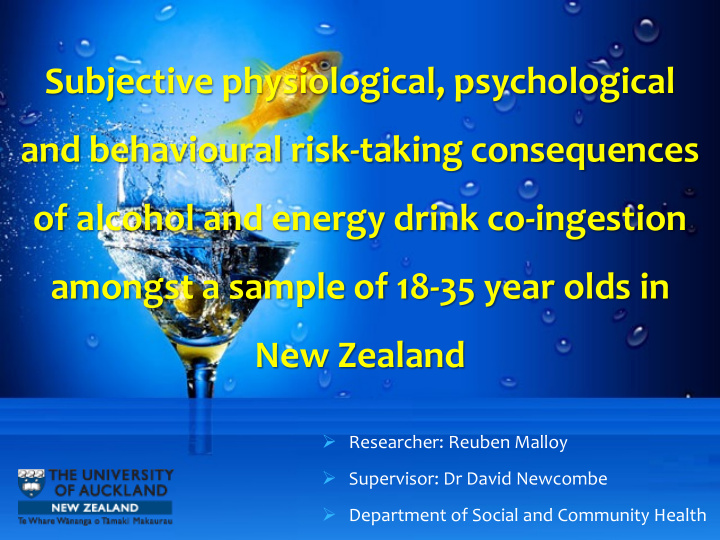



Subjective physiological, psychological and behavioural risk-taking consequences of alcohol and energy drink co-ingestion amongst a sample of 18-35 year olds in New Zealand Researcher: Reuben Malloy Supervisor: Dr David Newcombe Department of Social and Community Health
Alcohol in New Zealand 600 – 1000 NZ deaths annually, 2.5 million globally 80% of adults are ‘past year drinkers’ – 19% ‘hazardous’ Direct, Indirect, social and economic harms Cost New Zealand $3.9 billion in economic costs in 2009 HPA recommendations: no more than≤2 stds/day for women, 3 for men Relatively new practice of alcohol consumption; co-ingestion of alcohol and energy drinks Raises concerns regarding the potential for increased consumption, physiological and psychological side effects, risk- taking behaviours, and maladaptive drinking practices
Alcohol mixed with Energy Drinks Practice is becoming increasingly popular Stimulatory vs depressant effects: opposing theories Primary areas of contention: ‘masking effect’ of EDs • The interactive effect of EDs and alcohol • Risk-taking behaviours • No New Zealand Literature
Pharmacology Alcohol • Depressant • Agonist on the GABA ᴬ , Glycine and Adenosine inhibitory • receptors Resulting in sedation and lower levels of anxiety • Caffeine • Psychostimulant • Antagonist on the Adenosine receptors and increases • Dopamine transmission Increased levels of anxiety, tension and restlessness • Increased feeling of being alert, energetic, less fatigued and • more awake.
Literature Review Risk Taking Behaviours: opposing results AmED increases likelihood of risk taking behaviours • Those who consume AmED are inherently greater risk- • takers Less likely to engage in risk-taking behaviours • No significant difference across alcohol and AmED • users
Literature Review Psychological Consequences Some decreased (sadness, confusion, exhaustion) • whilst others increased ( tension and irritability) during AmED Remained similarly alert but with impaired reaction • time Perceived intoxication/masking effect •
Literature Review Motives Hedonistic outcomes and pleasurable taste • Ease of access and low cost • Reduced perception of intoxication – a need to drink • more Reduced fatigue and time to intoxication • ED’s mask the ‘flavor’ of alcohol •
Literature Review Physiological Consequences Some decreased (slurred speech, walking difficulties • and nausea) and others increased (heart palpitations, sleep difficulties, agitation, tremors and increased speed of speech) Improves reaction time, psychomotor speed and • driving performance. No difference in reaction time and motor coordination •
Project Overview Utilizing an online survey that is a modified version of a questionnaire created by Peacock and colleagues This study will Add a New Zealand perspective to the academic • literature regarding the interactive effects of alcohol and energy drink co-ingestion Improve our understanding of AmED use • Explore AmED use in New Zealand •
Aims 1) Explore patterns of alcohol and AmED consumption amongst a sample of 18-35 year olds in NZ 2) Explore any differences in the behavioural, psychological and physiological outcomes of AmED use 3) Discern if there are any differences in the risk taking behaviours of AmED and alcohol users 4) Analyse participant motives for consuming energy drinks with alcohol
Study Design Cross-sectional study utilising an online survey modified from a questionnaire developed by Peacock and colleagues and informed by the literature Created and hosted on Lime Survey Quantitative Data collected from participants Main objectives: To explore differences between alcohol and AmED use within a • New Zealand context in relation to use, motives, behavioural, psychological and physiological consequences, and risk-taking behaviours . Ethics approval granted on 1 st July by the UAHPEC
Recruitment Participants are individuals in New Zealand between 18-35 years Recruitment Methods Via posters and through a Facebook page
The Survey LimeSurvey Participant Information Sheet • Questionnaire • Prize Draw • Pilot test Question Development o Physiological Outcomes o Energy drink experience o Psychological Outcomes (POMS) o Alcohol Experience (AUDIT-C subscale) o Risk-taking Behaviours (RT-18) o AmED Experience o Demographics o Motivating Factors (CACEQ)
Preliminary Results Age Valid 310 N Missing 20 Mean 21.6 Std. Deviation 3.1 Range 17
Preliminary Results
Preliminary Results How many standard alcoholic drinks did you have in a single typical drinking session when you were having alcohol AND energy drinks? Frequency Percent Cumulative Percent How many standard drinks containing alcohol do you have on a typical day when you are drinking? 1.4 .0 2 .6 Frequency Percent Cumulative 10.8 1.0 13 3.9 Percent 21.6 2.0 15 4.5 0 47 14.2 14.2 30.2 3.0 12 3.6 1 or 2 68 20.6 34.8 38.1 4.0 11 3.3 3 or 4 78 23.6 58.5 51.8 5.0 19 5.8 5 or 6 69 20.9 79.4 62.6 6.0 15 4.5 7 to 9 35 10.6 90.0 71.2 7.0 12 3.6 10 or more 33 10.0 100.0 77.7 8.0 9 2.7 100.0 Total 330 80.6 9.0 4 1.2 89.2 10.0 12 3.6 89.9 11.0 1 .3 92.8 12.0 4 1.2 95.0 14.0 3 .9 97.1 15.0 3 .9 97.8 16.0 1 .3 98.6 17.0 1 .3 100.0 20.0 2 .6 42.1 Total 139 57.9 Missing System 191 100.0 Total 330
Discussion Due to the opposing natures of EDs and alcohol, differing theories regarding the overall interaction have developed. There are a variety of opposing results within the existing literature across regarding the psychological, physiological and risk-taking consequences, and motivating factors. Preliminary analysis of the data indicates higher consumption rates of alcohol during AmED compared to alcohol only sessions. ‘Masking effect’
Limitations Cross-sectional study Data was only collected at one point in time • Self-selection and snow ball sampling methods Results have limited generalisability • Self reported questionnaire Cannot guarantee survey was answered truthfully • Non-response bias Large number of individuals began but did not • complete the survey
Questions?
Recommend
More recommend